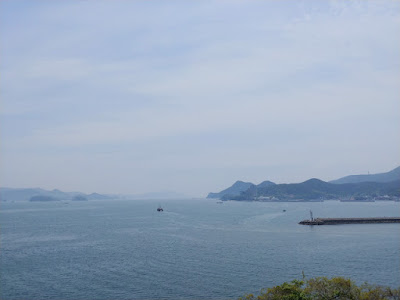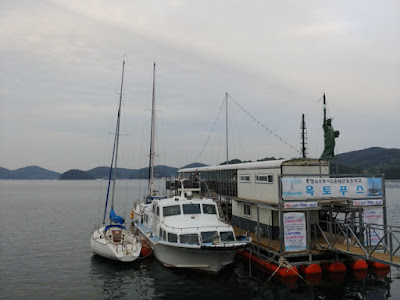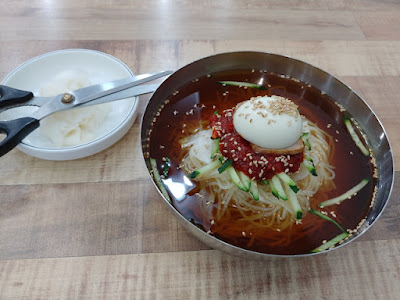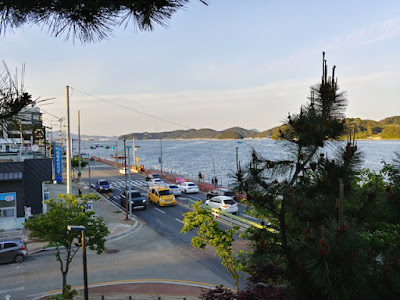I've lost all track of time and am still sleep deprived but working on all the bits, like finding a dentist in my host city, doing laundry, and organizing all the fieldwork. I woke up today wishing I could escape to an island and hide for a few days without a computer, but I need to be able to figure out how to rest in each place that I am. This is a view from Admiral Yi Sun-sin Park in Tongyeong, the gorgeous coastal city in the southeastern corner of Korea. Tongyeong is a peninsula and something like 300+ islands.
To process bit by bit, this is only about the non-study parts of my trip. Of which there were not a lot because my teacher took his responsibility very seriously. But he was kind enough to take me to this park one day for lunch, and his wife packed us a lunch that we could eat outside. This is the statue of Admiral Yi, who was by all accounts an incredible naval general the world over. According to the signage, he won all of the 32 battles he led, against the Japanese.
This corner of Korea was obviously the closest to Japan and where they often came to attack to try and penetrate the rest of the mainland and supply those in other ports or areas. Admiral Yi was unusual then (and now) in that he listened to people, whether his enlisted men or locals, to learn about the tides, currents, moon, enemy movements, etc., and then made tactical decisions based on that intel. He was beloved and trusted, and used a maneuver that worked only because of the very specific geography of Tongyeong: tons of tiny islands that could block the view of the enemy plus water that only the experienced locals knew how to read and navigate. He would lure Japanese ships past islands into seas where his ships in an open crane-wing formation would then fire. The Japanese didn't know what was coming because the islands blocked their view as they pursued Korean boats pretending to retreat.
He's also famed for reviving the Korean turtle ships and you can see the tip of a cannon on the bottom of this pic. The super famous battle was after he had been framed by some other dude who wanted to be in charge and got Yi thrown into jail, tortured, and almost killed. Of course, the other dude immediately lost to the Japanese and was killed so Yi was released and restored to his position but only had 13 boats left (the other guy lost the rest to the enemy). Because he was really good at his job, he managed to win the Battle of Myeongnyang against over 300 Japanese ships.
Even in death, when shot by a bullet during his last fight against the Japanese, he insisted that no one be told he was dying (as he knew that would be a major morale buster) and so his nephew had to wear his uniform and beat the war drums until they won the battle.
This park was under some path construction when we visited, and includes poetry along the paths.
We looked for a shady spot for a picnic lunch and ended up next to bamboo, very apt!
The area where I stayed is technically a part of town that used to be...the sea! They built more land here across from the more central areas of the original city. My teacher managed to find a guest house for women only with a super friendly and kind owner that was very close to his home, so we commuted together every day. It was a short walk to the water and a long walkway for bicycles and pedestrians. Boats changed daily but this was always there.
When we went to work out of his "dusty" studio (aka where the messier work of bamboo processing happens), his neighbor (aka his friend's daughter) came by as she was in town briefly. After a long talk she invited us to her studio in progress, where she does Tongyeong quilting (called nubi).
Bak Kyoung-hee is originally from Tongyeong and learned nubi from her mom. She lived in Seoul for 20 years or so and had developed a thriving business of her products that she ran out of Seoul and also Vietnam, where she lived part of the year. But she felt she needed to return to her hometown in some capacity to continue this work of the quilting tradition. I have heard versions of this story a lot from women who do this return in their 40s.
Her mom asked my teacher to let her know if there was any real estate so she could set up studio back home. Turns out the building next door to him was going up for sale! So it has been under construction for a while and she is set up on the 2nd floor of a 3-story building. The views are wonderful. Again, not the only studio I've seen of a working artist that has this kind of view.
This was a set that won her a prize, and she explained that people assume that machine quilting is much easier and faster than hand quilting.
I didn't do a great job capturing the detail here but clearly it's NOT a quick and easy process because so much of the surface is covered in stitches, in this traditional design of the spiral square.
This is a detail of both machine and hand stitching on a giant blanket.
An insane amount of work. Here she is with my teacher, Jo Dae-yong (a national treasure, more on him soon).
These are placemats from her collection. It was so refreshing to meet her and see that there are people here working in a direction that feels less lonely now. She said she was killing herself with her workload and constant travel, and when she decided to shut down the big business and do her own thing here, she realized that she could have just done that all along. But in a way I don't think so. The whole experience is part of the journey, and very necessary.
On an evening after study, I rashly grabbed a cab to another part of the city just to see something different. I had so little time to sightsee, and the area I went was very quiet, most businesses closed.
Very distorted image of one part of Dongpirang, an area covered with murals. I went backwards by accident but was in a rush to just do something different and stretch my legs.
The big disappointment was that the place I wanted to eat was closed (though I had walked far to get there around the port) so by the time I backtracked to get home, I was so hungry that I walked into this milmyeon place. I'm used to buckwheat noodles in this dish but the wheat noodles were actually better than I feared.
On Saturday of my stay, there was a special presentation series that was beginning, starting with the national treasure of a protected intangible property, Namhaean byeolsin gut (I'm going to do a murderous translation here: southern coast star god/spirit ritual. The translation for the last word is often exorcism but not sure that is a great translation nor does it have good connotations to English speakers). This is the guy who presented everyone and did a surprise introduction of me to the audience.
Jeong Young-man is the national intangible property holder of this ritual, and grew up in a family of shamans (known in Korea as mudang). His parents refused to teach him even though he begged them to learn, as they said he couldn't make a living doing this, so he learned secretly from his aunt and uncle. I believe he also had a lot of encouragement from his grandmother. The incredible thing now is that his daughter and two sons are also in training (in the previous pic, his daughter is running the slide show).
Here he is showing us all of the different parts and meanings of the costume that his disciple Yi Sun-hee is wearing. I had met her early in my study and just thought she worked in the office where my teacher had his "clean" studio (aka where you weave bamboo after it has been processed), along with the tall guy who did the intros. She had even brought Mr. Jeong to the studio while I was weaving but I had no idea who he was! I thought, based on his convo w/my teacher, that he was an instrument maker because he knew so much about bamboo for piri, a double-reed traditional bamboo instrument. It's always a trip when you find out that the people you meet are so much more than who you think they might be.
He showed us the embroidery on her back and the significance of that, which of course made me think of the show back in Cleveland that I was able to see last year.
He went through the different objects used in these rituals (gut, or more helpfully Romanized for English speakers, goot), and after the bells he showed he picked up this bamboo branch with leaves still intact and paper streamers.
If you're wondering why I don't have better explanations for everything, it's because a lot went over my head and I was at various points in tears when he sang. I was so over the top happy that my circuitous path to learning what I had to learn brought me here. I took lots of pics and videos to show to my friend back in the US who is very invested in this part of Korean culture. I've known her since I was 17 and our paths had come together because of our violin study, diverged, and then come together again as we figured out our paths. Turns out she had already gone to this ritual in 2019 with her daughter and met these folks! As well as my host professor in Jeonju...it's a small, small world.
I didn't get to eat the most famous food of this area, oysters, but did get to eat anchovies (myeolchi) in various side dishes, which is also a huge export of the seas here. This is one of their other famous dishes, Chungmu kimbap (b/c Tongyeong used to be called Chungmu). This is NOT a tasty version of it but I was desperate to try so I just found the closest place for dinner one evening. The story is that regular kimbap would spoil while men were out at sea working all day, so one wife figured that if she wrapped the rice in seaweed separately and then had side dishes of fermented food, then nothing would go bad. I look forward to trying this again at a good place, with a healthy set of teeth (at this point I had lost part of a molar).
One night at the guesthouse, they had a pipe burst so we weren't going to have water until 8pm. I asked the owner for a recommendation for a place to eat, and she mentioned this curry place. I love the options in Korea for half & half dishes, so you can try two different things instead of commit to one. She said, we're going out, too (b/c...no water!), and her husband drove her and their younger son and me to that area. They even invited me to eat with them but I said no, no.
After dinner, I wanted to walk along the water for a bit and after a while I noticed people inside a storefront waving frantically at me: the owner and her family! They insisted that I come inside and eat dinner with them. Korean hospitality is truly heartwarming. They fed me second dinner and we talked a bunch and then I rode back with them in time to finally shower after a long day. The next night was my last and I had left for dinner before she could invite me to eat with them in their home downstairs! The automatic unthinking generosity really helped me get through this intense visit.
This was my final walk before I got a ride back to Jeonju the next day with the mudang's daughter Jeong Eun-ju, who drove Yi Sun-hee and myself so that they could get additional training at the national center for intangible heritage. The stars kept aligning so that I didn't need to figure out a bus trip home. And this is only the tip of the wonderful Tongyeong experience that I had. The heart of it I'll share soon! [omg can you tell my grammatical structure is suffering because of all the Korean language usage? haha]


































No comments:
Post a Comment